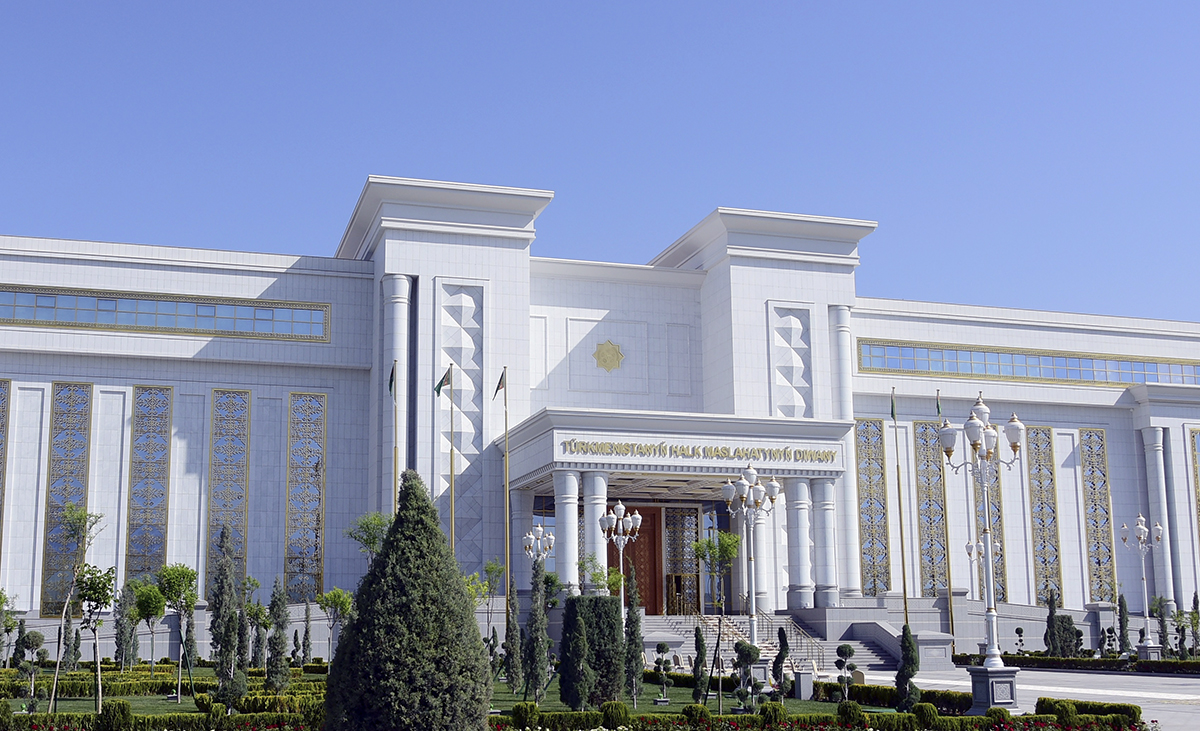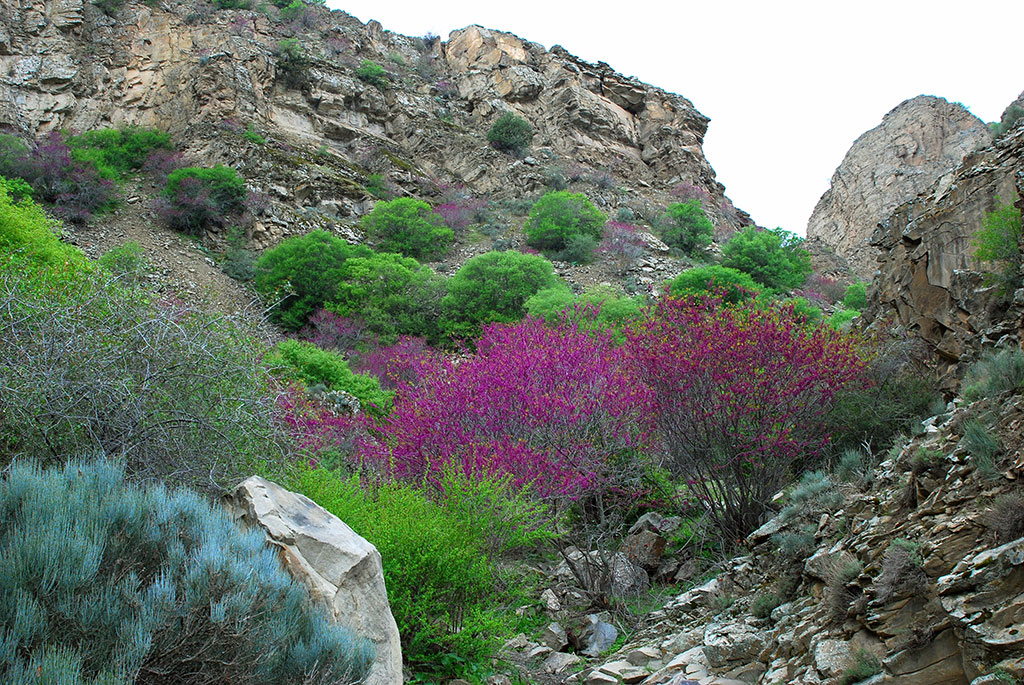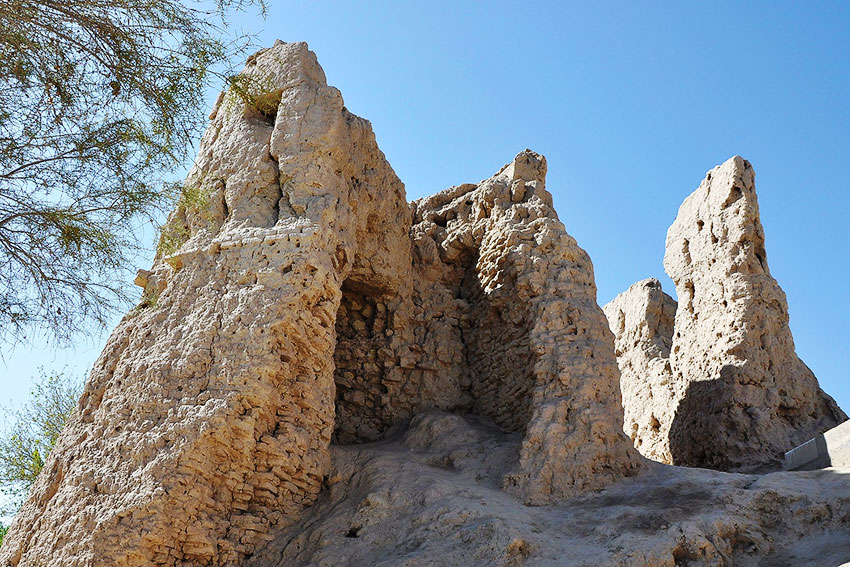Merv - a real megalopolis of ancient world arose on the fertile soil of the oasis of the Murgap, represents a set of cities closely located with each other, and belongs to different periods. While it was a tradition for other ancient cities to erect a new settlement on the ancient places, here the in every epoch buildings were constructed on the river courses and deltas which changed their courses in the direction from east to west. As a result, the modern Murgap where today Mary city is located moved away from its ancient course for about 30 kilometers!
The ruins of Merv city today occupy thousands of hectares. Gonur-depe, Yaz-depe, Erk –gala, Gyavur-gala, Chilburj, Sultan-gala, Abdullah khan-gala, Bayramaly khan-gala-names of these sites witness centuries-old history of rise and fall of kingdoms and dynasties , wars and uninterrupted sequence of chronology of events , revival of the city after the acute social calamity. And today it is a real treasure for archaeologists who now come here from various world countries and carry out explorations and excavations in the land of Mary year after year continuing their scientific traditions of their predecessors.
Merv is not only the name of one of the oldest cities of the east but also the whole encirclement on the old delta of the Murgap River. From time immemorial, these lands attracted people with their fertility and abundance of water. In the bronze epoch the generous land which was later called the country of Margush or Margiana, was settled with cultivators and semi-nomad tribes who created the unique culture of ancient type which has been recognized today as the independent centre of world civilization like Mesopotamia, Egypt, India and China. In fact, Merv rose about the VII century BC on the present place of Erk –gala city and quickly became the centre of the entire oasis.

In the early IX century the Khorasan viceroy of the caliphate of al-Mamun, the son of caliph Harun ar-Rashid settled in Merv. In 813, al-Mamun himself became caliph but yet long before it lived in Merv. Historians tell that in that period the city in fact played the role of the capital city of the caliphate –all instructions and appointments for all the Arabic government were made there. That time Merv experienced a short but a flourishing period in its history. Architectural monuments of the IX century did not remain but it is known that in Gyavur-gala first the mosque of Banu Makhan was reconstructed in Merv. Archaeologists have discovered its traces. A large underground reservoir for water with a dilapidated cupola is an only landmark by which it is possible to find the old complex of the legendary mosque.
In the X-XI centuries the epoch of unseen cultural uplift started and then Merv attracted the most famous intellects of the Islamic world, poets, artists, and architects who have left traces of their hands here. It is sufficed to say that here several years Omar Khayyam and Fahr-ad-Din Gurgani, the author of the epic “Vis and Ramin” lived and worked for several years. Equally a thousand years ago Merv became the largest city in Central Asia and one of the largest in the entire Muslim east: together with its surroundings its area reached 1800 hectares and the population was - 150 000. Taking into account the fact that the mass of cities of that period had population from two to five thousand people, one can imagine the scale of Seljuk Merv. It rose from the former suburb of Gyavur-gala on the canal Madjan where the caliph Abu Muslim moved his government residential and bazar in the mid of the VIII century and built there a cathedral mosque.
Today on this place, the mausoleum of sultan Sanjar is situated. Besides this grandiose erection among the ruins of Merv, there are several architectural monuments of that wonderful epoch which once became frequently visited places for tourists and pilgrims. This small memorial mosque of Muhammad ibn-Zayd with its excellent façade and interior, the mausoleum of Khudaynazar ovuliya and mosque of Talkhatan-baba, almost miniature masterpieces of ancient masters like mausoleums of Askhabs, mosque of Khoja Yusuf Hemedani and of course mysterious clay forts of Great and Small Gyz-gala with their severe rhythm of closely located pillars creating ribbed façades also speak of this fact.

Almost at every kilometer of the Merv soil one can see this or another evidence of the remote past. Around the capital megalopolis yet since the Parthian time there located a range of closely settled towns and separate rich mansions. Sometimes it is not clear that where the ruins of the city itself are and where is the conglomerate of growing villages. In the Х century citizens by some estimations, made up about 40 % of the total number of population in the oasis. All this urban picture in the area of Merv like in other highly-developed city centres of Turkmenistan, radically changed after the Mongol invasion: to reach its previous height the oasis could not , not only consequence of frequent political cataclysms but natural calamities also told upon this fact. The climate became drier and pastures became barren. The Murgap shallowed, cultivated areas were reduced and people started to leave their settlements. At least two hundred years passed before Merv again rose under sultan Shahrukh. There arose a new urban territory enveloped with strong walls today known as Abdullah-khan-gala. And in the XIX century the oasis was again opened for the world and this time thanks to the travelers and scientists from Europe and Russia…
In the photos: walls and towers of the fort Chilburj: a modern view and reconstruction of its original look about two thousand years ago.
The ruins of Merv city today occupy thousands of hectares. Gonur-depe, Yaz-depe, Erk –gala, Gyavur-gala, Chilburj, Sultan-gala, Abdullah khan-gala, Bayramaly khan-gala-names of these sites witness centuries-old history of rise and fall of kingdoms and dynasties , wars and uninterrupted sequence of chronology of events , revival of the city after the acute social calamity. And today it is a real treasure for archaeologists who now come here from various world countries and carry out explorations and excavations in the land of Mary year after year continuing their scientific traditions of their predecessors.
Merv is not only the name of one of the oldest cities of the east but also the whole encirclement on the old delta of the Murgap River. From time immemorial, these lands attracted people with their fertility and abundance of water. In the bronze epoch the generous land which was later called the country of Margush or Margiana, was settled with cultivators and semi-nomad tribes who created the unique culture of ancient type which has been recognized today as the independent centre of world civilization like Mesopotamia, Egypt, India and China. In fact, Merv rose about the VII century BC on the present place of Erk –gala city and quickly became the centre of the entire oasis.

In the early IX century the Khorasan viceroy of the caliphate of al-Mamun, the son of caliph Harun ar-Rashid settled in Merv. In 813, al-Mamun himself became caliph but yet long before it lived in Merv. Historians tell that in that period the city in fact played the role of the capital city of the caliphate –all instructions and appointments for all the Arabic government were made there. That time Merv experienced a short but a flourishing period in its history. Architectural monuments of the IX century did not remain but it is known that in Gyavur-gala first the mosque of Banu Makhan was reconstructed in Merv. Archaeologists have discovered its traces. A large underground reservoir for water with a dilapidated cupola is an only landmark by which it is possible to find the old complex of the legendary mosque.
In the X-XI centuries the epoch of unseen cultural uplift started and then Merv attracted the most famous intellects of the Islamic world, poets, artists, and architects who have left traces of their hands here. It is sufficed to say that here several years Omar Khayyam and Fahr-ad-Din Gurgani, the author of the epic “Vis and Ramin” lived and worked for several years. Equally a thousand years ago Merv became the largest city in Central Asia and one of the largest in the entire Muslim east: together with its surroundings its area reached 1800 hectares and the population was - 150 000. Taking into account the fact that the mass of cities of that period had population from two to five thousand people, one can imagine the scale of Seljuk Merv. It rose from the former suburb of Gyavur-gala on the canal Madjan where the caliph Abu Muslim moved his government residential and bazar in the mid of the VIII century and built there a cathedral mosque.
Today on this place, the mausoleum of sultan Sanjar is situated. Besides this grandiose erection among the ruins of Merv, there are several architectural monuments of that wonderful epoch which once became frequently visited places for tourists and pilgrims. This small memorial mosque of Muhammad ibn-Zayd with its excellent façade and interior, the mausoleum of Khudaynazar ovuliya and mosque of Talkhatan-baba, almost miniature masterpieces of ancient masters like mausoleums of Askhabs, mosque of Khoja Yusuf Hemedani and of course mysterious clay forts of Great and Small Gyz-gala with their severe rhythm of closely located pillars creating ribbed façades also speak of this fact.

Almost at every kilometer of the Merv soil one can see this or another evidence of the remote past. Around the capital megalopolis yet since the Parthian time there located a range of closely settled towns and separate rich mansions. Sometimes it is not clear that where the ruins of the city itself are and where is the conglomerate of growing villages. In the Х century citizens by some estimations, made up about 40 % of the total number of population in the oasis. All this urban picture in the area of Merv like in other highly-developed city centres of Turkmenistan, radically changed after the Mongol invasion: to reach its previous height the oasis could not , not only consequence of frequent political cataclysms but natural calamities also told upon this fact. The climate became drier and pastures became barren. The Murgap shallowed, cultivated areas were reduced and people started to leave their settlements. At least two hundred years passed before Merv again rose under sultan Shahrukh. There arose a new urban territory enveloped with strong walls today known as Abdullah-khan-gala. And in the XIX century the oasis was again opened for the world and this time thanks to the travelers and scientists from Europe and Russia…
In the photos: walls and towers of the fort Chilburj: a modern view and reconstruction of its original look about two thousand years ago.






